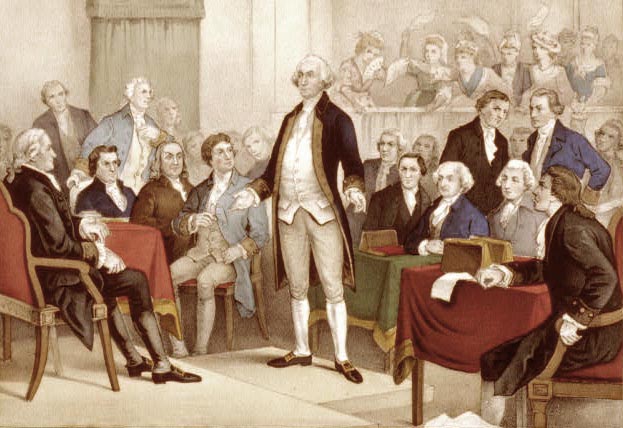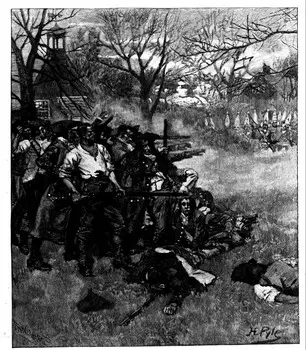Philadelphia was the headquarters for the Americans during the Revolutionary War. It hosted the First and Second Continental Congress'. General Howe attacked George Washington's forces in Philadelphia on September 26, 1777.
Without any problems, British forces had taken over Philadelphia. The colonists carried out all supplies from the city. General Howe awaited supplies. It took two months before the supplies got close. However, during this time General Burgoyne was defeated at Saratoga. With the French on the American side, General Howe fled Philadelphia and headed for New York.
The British had gained control of Philadelphia and lost it without a shot ever being fired. This historic city played a huge part in the Revolutionary War for the colonists.
Revolutionary War
Saturday, September 24, 2011
Philadelphia - Liberty Bell
Liberty Bell - The Liberty Bell was carried out of the city when any attacks happened, to prevent damage to it by British troops.
Philadelphia - Declaration of Independence
Declaration of Independence - The Declaration of Independence was signed in Philadelphia during the Second Continental Congress.
The Battle of Trenton
General Washington led his troops across the Delaware River the night of December 25, 1776. He was planning to lead a surprise attack on the Hessians stationed in Trenton. After landing on the other side of the Delaware River, the soldiers made their way to Trenton and found the Hessians sleeping and unprepared. General Rahl, the leader of the Hessian's at Trenton, ignored a message the previous day of a possible American attack.
The Hessians were completely surprised and tried to regroup inside the town. However, constant artillery fire and attacking soldiers from all directions led to the surrender of General Rahl, who was fatally wounded. The Americans suffered only four wounded. The Hessians suffered 20 killed, about 100 wounded, and over 900 captured. This was a great victory for the Americans, both physically and psychologically. This was a much needed morale booster for the Americans.
The Hessians were completely surprised and tried to regroup inside the town. However, constant artillery fire and attacking soldiers from all directions led to the surrender of General Rahl, who was fatally wounded. The Americans suffered only four wounded. The Hessians suffered 20 killed, about 100 wounded, and over 900 captured. This was a great victory for the Americans, both physically and psychologically. This was a much needed morale booster for the Americans.
The Treaty of Paris
Representatives from both sides of the war met in Paris to come to an agreement. In the Hotel d'York in Paris, France the Treaty of Paris was signed. On September 3, 1783, the treaty was signed by Benjamin Franklin, John Adams, John Jay, and David Hartley.
The key points of the treaty were as follows:
After being signed, the treaty was ratified by all parties on January 14, 1784. The Treaty of Paris ended the Revolutionary War, and gave freedom to the American citizens.
The key points of the treaty were as follows:
- Acknowledging the Thirteen Colonies to be free, sovereign and independent States, and that the British Crown and all heirs and successors relinquish claims to the Government, propriety, and territorial rights of the same, and every part thereof;
- Establishing the boundaries between the United States and British North America (for an account of two strange anomalies resulting from this part of the Treaty, based on inaccuracies in the Mitchell Map—see Northwest Angle and the Republic of Indian Stream);
- Granting fishing rights to United States fishermen in the Grand Banks, off the coast of Newfoundland and in the Gulf of Saint Lawrence;
- Recognizing the lawful contracted debts to be paid to creditors on either side;
- The Congress of the Confederation will "earnestly recommend" to state legislatures to recognize the rightful owners of all confiscated lands "provide for the restitution of all estates, rights, and properties, which have been confiscated belonging to real British subjects [Loyalists]";
- United States will prevent future confiscations of the property of Loyalists;
- Prisoners of war on both sides are to be released and all property left by the British army in the United States unmolested (including slaves);
- Great Britain and the United States were each to be given perpetual access to the Mississippi River;
- Territories captured by Americans subsequent to treaty will be returned without compensation;
- Ratification of the treaty was to occur within six months from the signing by the contracting parties.
After being signed, the treaty was ratified by all parties on January 14, 1784. The Treaty of Paris ended the Revolutionary War, and gave freedom to the American citizens.
Paris - American Signers
Signers of the Treaty of Paris - The signers on the American side were Benjamin Franklin, John Adams, and John Jay.
The Battles of Concord and Lexington
British General Gage ordered a march on Concord to seize the stockpile of arms and ammunition the colonists kept there. On April 19, 1775, after learning of the British march, a group of militiamen quickly formed in Lexington to hold off the British attack. The British advanced on the men and a shot was fired. After the smoke cleared, the British suffered only one wounded. Eight Minutemen died under Captain Parker.
The British continued on toward Concord. They secured the roads leading into the town and started destroying the weapons. Parker's Minutemen arrived at Lexington and saw the smoke. They attacked the British, killing many men. The British then retreated and marched back to Boston.
The British continued on toward Concord. They secured the roads leading into the town and started destroying the weapons. Parker's Minutemen arrived at Lexington and saw the smoke. They attacked the British, killing many men. The British then retreated and marched back to Boston.
Subscribe to:
Posts (Atom)










